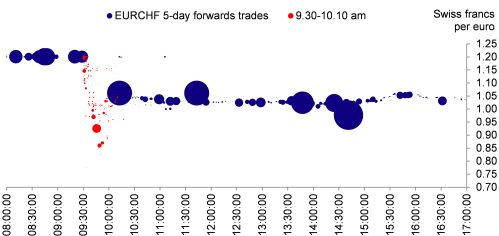Big Data jigsaws for Central Banks – the impact of the Swiss franc de-pegging
Olga Cielinska, Andreas Joseph, Ujwal Shreyas, John Tanner and Michalis Vasios
Bank Underground 06 APRIL 2017
The Bank of England has now access to transaction-level data in over-the-counter derivatives (OTCD) markets which have been identified to lie at the centre of the Global Financial Crisis (GFC) 2007-2009. With tens of millions of daily transactions, these data catapult central banks and regulators into the realm of big data. In our recent Financial Stability Paper, we investigate the impact of the de-pegging in the euro-Swiss franc (EURCHF) market by the Swiss National Bank (SNB) in the morning of 15 January 2015. We reconstruct detailed trading and exposure networks between counterparties and show how these can be used to understand unprecedented intraday price movements, changing liquidity conditions and increased levels of market fragmentation over a longer period.
Political setting and event
Following the GFC, G20 leaders were quick to agree on the comprehensive collection of OTCD market data. This has been implemented as parts of European Market Infrastructure Regulation (EMIR) and the Dodd-Frank Act in the EU and the US, respectively. The European requirement began in 2012 although the data were not available until 2014. This truly catapulted supervisors and regulators into the league of Big Data with tens of millions of daily reported transactions and counterparty exposures collected by a handful of trade repositories.
We provide one of the first and most granular empirical studies of foreign exchange (FX) OTCD markets to date using data from the largest trade repository (DTCC). FX OTCD markets are the second largest class of derivative markets with outstanding notional amounts of about the same size as annual world output, or 75 trillion USD, at the end of 2015. Out of this, the Swiss franc (CHF) accounted for about 4 trillion. We investigate the short and longer-term impacts of the completely unexpected decision of the SNB to remove the floor of 1.20 CHF per euro on 15 January 2015 at 9.30am. In particular, we look at the price movements around the event, liquidity conditions and the market micro structure. We do not analyse the merits of the policy move itself. Rather our focus is on understanding the wider effects of the decision on foreign exchange markets.
Most of the analysis focuses on the EURCHF forward market. An FX forward is an OTCD contract where two parties agree to exchange two amounts of a currency pair at a specified maturity date in the future. Forwards are used for risk management (hedging) and speculation.
Market Structure
Our study covers the period between November 2014 and March 2015, for which we collected data from 400,000 unique transactions and 3 million open positions (exposures) in the EURCHF market. Given the bilateral structure of the data, it is well suited for the use of tools from network science which provides a bird’s eye view of complexity. Figure 1 shows the network of outstanding exposures in the EURCHF forward market on the day before the event (14 January 2015). The circles or nodes are counterparties in the market which are connected by outstanding positions. The size of nodes and thickness of connections are both given by the notional amounts of aggregated positions. The colour coding is derived from the position of individual counterparties within the market. An inner core (red nodes) of dealer banks holds the market together (market making). Larger clients form the outer core (blue nodes). These are often connected to more than one dealer or engage in buying and selling the Swiss franc. The remaining clients (green nodes) constitute the periphery. They usually have smaller exposures and either only buy or sell the Swiss franc.
Two main insights can be derived from this network visualisation of the market. First, there is a clear segregated structure of dealer banks, serving their respective “clouds” of clients, with large clients (mostly blue) being connected to several dealers. Second, the large size of dealer banks as depicted by the size of the red nodes, and their central position in the trading network, demonstrates the important role they play: they connect different parts of the market with each other. On the downside, their central role means that a failure of any of the big dealers could lead to severe market disruptions.
Figure 1: Exposure network in EURCHF forward market on 14 January 2015. Source: DTCC and Bank calculations
Short-term impact: The event-day
The EURCHF exchange rate moved rapidly with a peak to trough difference of 41% in the first 20 minutes after the SNB’s announcement. This has been unprecedented for a major currency. These price movements are well represented in the forward market. Figure 2 shows all executed trades on the event day, each trade depicted by a bubble whose size is proportional to its notional. Trades executed in the interval between 9.30 am and 10.10 am, when prices fall sharply before recovering to the new equilibrium price, are shaded in red. These observations point to poor liquidity conditions in the minutes after the event.
Given our bilateral data, we can investigate the underlying causes for these conditions. Indeed, the trading network between 9.30am and 9.50am on the day of the SNB event shows that the provision of liquidity by dealers was initially limited. The price reversal and eventual stabilisation coincides with a rebound in market-making activity by dealers.
Figure 2: EURCHF 5-day forwards trades executed on 15 January 2015 . Source: DTCC and Bank calculations
The V-shaped price movement between 9.30 am and 10.10 am and evidence on the prevailing liquidity conditions challenge the efficient market hypothesis. Under extreme circumstances, for example when there is a lack of market liquidity, prices can diverge far from fundamental values and overshoot. In the case of the Swiss franc de-pegging, if more liquidity had been available, arbitrageurs might not have allowed the Swiss franc to appreciate above the new equilibrium price. In other words, we should have seen the exchange rate quickly move to the seemingly new equilibrium price of around 1.05.
Longer-term impact
Taking a longer-term view we compare measures of volatility, illiquidity and market structure in the two and a half months before and after the event. As expected, measures of illiquidity (e.g. price dispersion) peaked on the day of the event. More surprisingly, they also stayed at elevated levels thereafter. This may be attributed to a new regime with higher market frictions such as search costs.
To investigate the reasons for these observations, we looked at the microstructure of bilateral daily activity to see if there are physical changes in the connectivity between counterparties. We extracted a “trading backbone” consisting of connections of similar contracts between the most active counterparties. The backbone of the EURCHF forward market is depicted in Figure 3 for the event day and 23 January. These two snapshots are representative for the time before and after the de-pegging, respectively. They indicate that the degree of market fragmentation in the months after the event increased, as measured by the number of connected sub-components in the backbone. A connected component is a group of nodes where each node can be reached from any other node via links within this group. Digging deeper, this could be linked to an observed over-proportional decline in inter-dealer links after the event. That is, the fraction of inter-dealer links is systematically lower in the months after the event. This is again in line with insights from network science, according to which a change in the fraction of so-called long-range connections, which are the inter-dealer links here, is often accompanied with qualitative changes to the system overall.
Figure 3: Trading backbone on 15 (left) and 23 (right) January 2015, which are indicative for the market connectivity before and after the de-pegging if the CHF
Conclusion & challenges ahead
We demonstrated how granular data from traditionally opaque OTCD markets can be used to shed light onto the structure and workings of such markets and how they react to unexpected events. This was made possible through the recent availability of regulatory transaction-level data. Looking at the EURCHF market around its de-pegging on 15 January 2015, we reconstruct the micro market structure of trading and exposure networks. We showed how this information can be used to understand the market movements on the day of the event as well as longer-term changes. Particularly, large price swings are associated with a lack of liquidity provision by dealers, while longer-term changes to the trading network may be the consequence of decreased inter-dealer activity flowing the months after the event. Last but not least, these data does not only provide new opportunities but also create new challenges associated to their sheer size and complexity. Nevertheless, we believe that the data will provide an invaluable source for supervisors, regulators and researchers to better guide and understand financial markets.
~~~
Olga Cielinska is a Portfolio Manager in the Bank’s Reserves Management Foreign Exchange Division, Andreas Joseph is a Research Economist at the Bank’s Advanced Analytics Research and Statistics Division, Ujwal Shreyas is a Data Scientist at the Bank’s Advanced Analytics Research and Statistics Division, John Tanner is a Manager at the Bank’s Financial Market Infrastructure Division and Michalis Vasios is a Research Economist at the Bank’s Financial Market Infrastructure Division.





